Learn
Stage Directions Review
In an earlier unit, you learned some terminology important to a basic understanding of the stage. Let's review that first. Look at the diagram below.
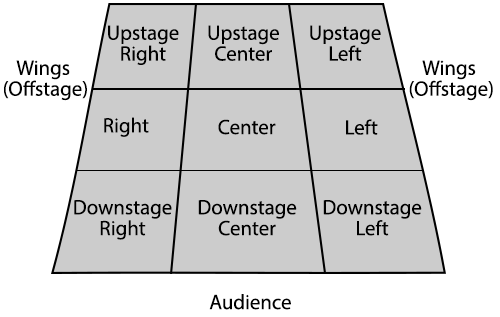
See larger version of the stage directions diagram here.
It is important to remember that the positions of left and right are from the actor's perspective. This means that if an actor is standing on stage looking at the audience, the actor's LEFT is stage left. The actor's RIGHT is stage right.
- If the actor moves closer to the audience, he or she is moving downstage.
- If the actor moves away from the audience, he or she is moving upstage.
Do you remember the term we used to describe movement on stage?
Actors will make entrancesappear on stage and exitsleave the stage . If an actor is given the direction to move from stage right to stage left, this is called a cross. When a director makes a decision about movement on stage, he/she is concerned about stage balance, which is keeping the action balanced across the stage. It is important to have a good understanding of these terms before we move to the next step.
Picturization
Blocking is all about picturization, which is the storytelling aspect of blocking. This means blocking is not only the movement, but also the character, emotion, motivation, and body language.
The eventual responsibility of blocking lies on the shoulders of both the actor and the director. As mentioned earlier, the job is part of a creative team! The actor and director have done their research and are working together towards a final common goal. This is composition, or the arrangement of the individual parts to the whole. It can show you more about the characters and even help to tell the story.
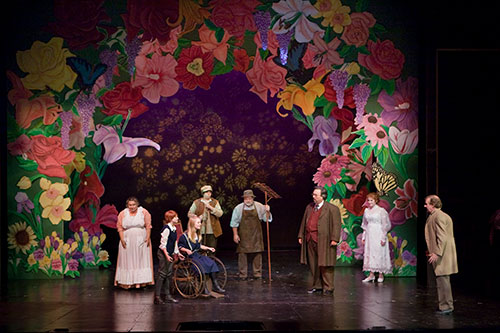
A still from a production of The Secret Garden. Image courtesy of Theatre Tuscaloosa.
The actors exist in the environment on stage and the audience is asked to believe in the environment and the characters existing within it. This helps to develop context, or something's relationship to the story.
Think about this example: The main character enters stage, dressed in black, and moves slowly to sit in a chair. As others enter -- also dressed in black -- they cross to her, hug her, and then take their seat. What is the possible setting and who is the main character?
The main character dressed in black means something because of the context it is set in. The composition created by the director, helps to develop the context.
Types of Rehearsals
But, let's back up. How does this final stage picture get to this point? Through the rehearsal process! There are six types of rehearsals; each type occurs in a particular way and in a particular order. Let's look at each of them!
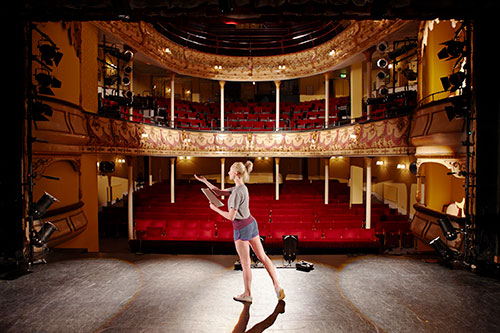
First is the read-through, which is rehearsal where the entire cast meets for first time to read through script. It is also referred to as a table read. This rehearsal gives a chance to learn about the story and who is playing each of the roles. This helps the director to begin building the community.
Next is a blocking rehearsal where the actors and director work out the movement of each scene of the show. Some directors give specific direction at this point, and other director allow the actors to make their own movement choices. Actors will record all movement using a pencil in their copy of the script; they use a pencil in order to erase and change notations as needed. The director is also very aware of the sight lines the line of sight from audience to the action on the stage at this point, ensuring that the audience can see the action.
A working rehearsal focuses on both movement and line delivery. During it, all pieces are being put together! The actor discovers the emotion of the show and the meaning of the lines. The memorization, or committing things to memory, of lines and blocking is expected at this point. Some directors will give specific dates for actors to have all blocking and lines memorized, while other directors allow actors to make their own decisions about this. Whatever happens, everyone agrees that the sooner everything is memorized and the actor can perform "off book," the better!
The fourth type of rehearsal we will discuss is the polishing rehearsal, which aims to perfect movement and line delivery. All aspects of the show are refined, or polished, at this point. The director makes changes to help the flow of the show and build to an emotional climax. At this point, choices should be finalized. The actor is further developing the choices that are already made, not trying out new ideas.
Next is the tech rehearsal, which is a rehearsal that focuses on the technical elements of the show, including lighting, sound, set, etc. These rehearsals happen towards the end of the rehearsal process, and the actors are only used to fine-tune the technical elements. This means that an actor may stand in one place on stage while lights are adjusted to his or her position. If there is a difficult set change, the director may practice a change from one scene to the next multiple times.
Finally, we've come to the dress rehearsal! This is when the show is run as if there is a paying audience. It's a final rehearsal with all aspects put into play. Actors wear full costume and make-up, and all tech elements are performed. The curtain call, or final bow, will also be practiced. During the curtain call, the actors return to stage once the show is over to accept the applause of the audience.
There is no stopping in a dress rehearsal. The purpose of a dress rehearsal is to be sure the show is ready for an audience. At times, invited guests and reviewers will attend the dress rehearsal. The role of the reviewer will be discussed in the next unit.
Directing the Actors
During both the blocking and working rehearsals, the director focuses on the picture being created by the actors on the stage. Professional actors are expected to always be aware of what they look like to an audience. However, when working with amateur actors, a director may have to give very specific direction to them. Let's look at the types of directions a director may give to an actor.
Full front is when an actor stands directly facing the audience. It is used when a character directly addresses the audience, and it can also be used if the actor is in a dream state.
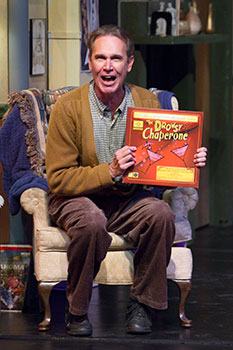
In this still from The Drowsy Chaperone, the actor is facing the audience and speaking directly to them. Image courtesy of Theatre Tuscaloosa.
The quarter turn is the most used move in blocking and it's used when an actor shares a scene with another actor. It allows the audience to see both actors easily. The actors will cheat out, meaning the actor adjusts his or her body with the audience in mind. This can be as simple as turning the downstage foot towards the audience. This simple move allows the audience to see more of an actor's body and face.
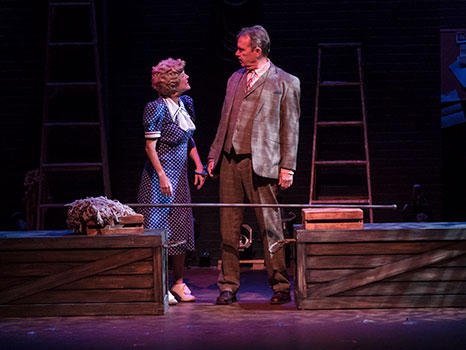
Two actors in a production of The 39 Steps are speaking to each other but have their bodies slightly angled so that the audience can see more of their bodies. Image courtesy of Theatre Tuscaloosa.
When actors turn towards each other, they are in profile. This helps build the intensity of a scene, as the audience is pulled into the conversation.
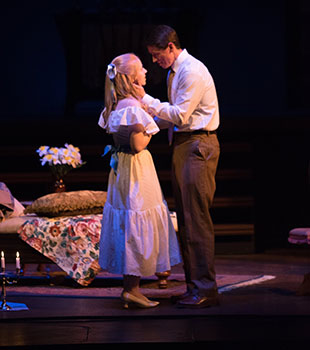
The audience sees these two actors in The Glass Menagerie in profile. We are drawn into their conversation. Can you see the differences between these actors in profile and the previous photo with the actors in a quarter turn? Image courtesy of Theatre Tuscaloosa.
The three quarter move has the actors turn quarter back to audience. It is used to direct audience's attention to another character, especially when the audience should be focusing on one specific actor on stage during a specific moment. When the other actors have most of their backs to the audience, it takes potential distractions away and the audience can focus on the specific actor. Although important at all times, an actor must be sure not to be guilty of upstaging, or drawing the attention of the audience. When an actor forces another actor to turn his or her back to the audience, when not required by the script, then the actor has upstaged him or her.

In a production of The Glass Menagerie, the downstage actress in the pink dress is in three quarter and she's looking towards the two actors upstage. Her stance directs the audience to look at those other two actors. Image courtesy of Theatre Tuscaloosa.
The last move we will discuss is full back, which is when an actor turns to face upstage. It is a dramatic move and generally for brief periods of time. This can also be used if a stage picture is trying to be created, but no dialogue shared.
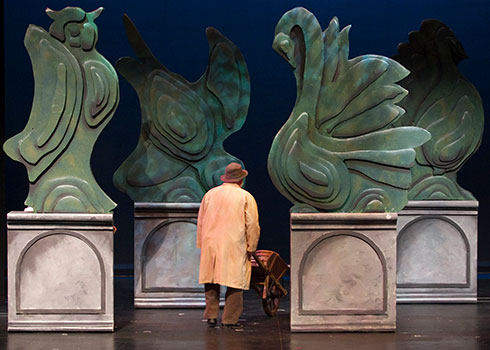
In a production of The Secret Garden, this actor is full back with his entire back to the audience. Do you see the difference between this movement and the girl in the pink dress in three quarter in the previous image? Image courtesy of Theatre Tuscaloosa.

